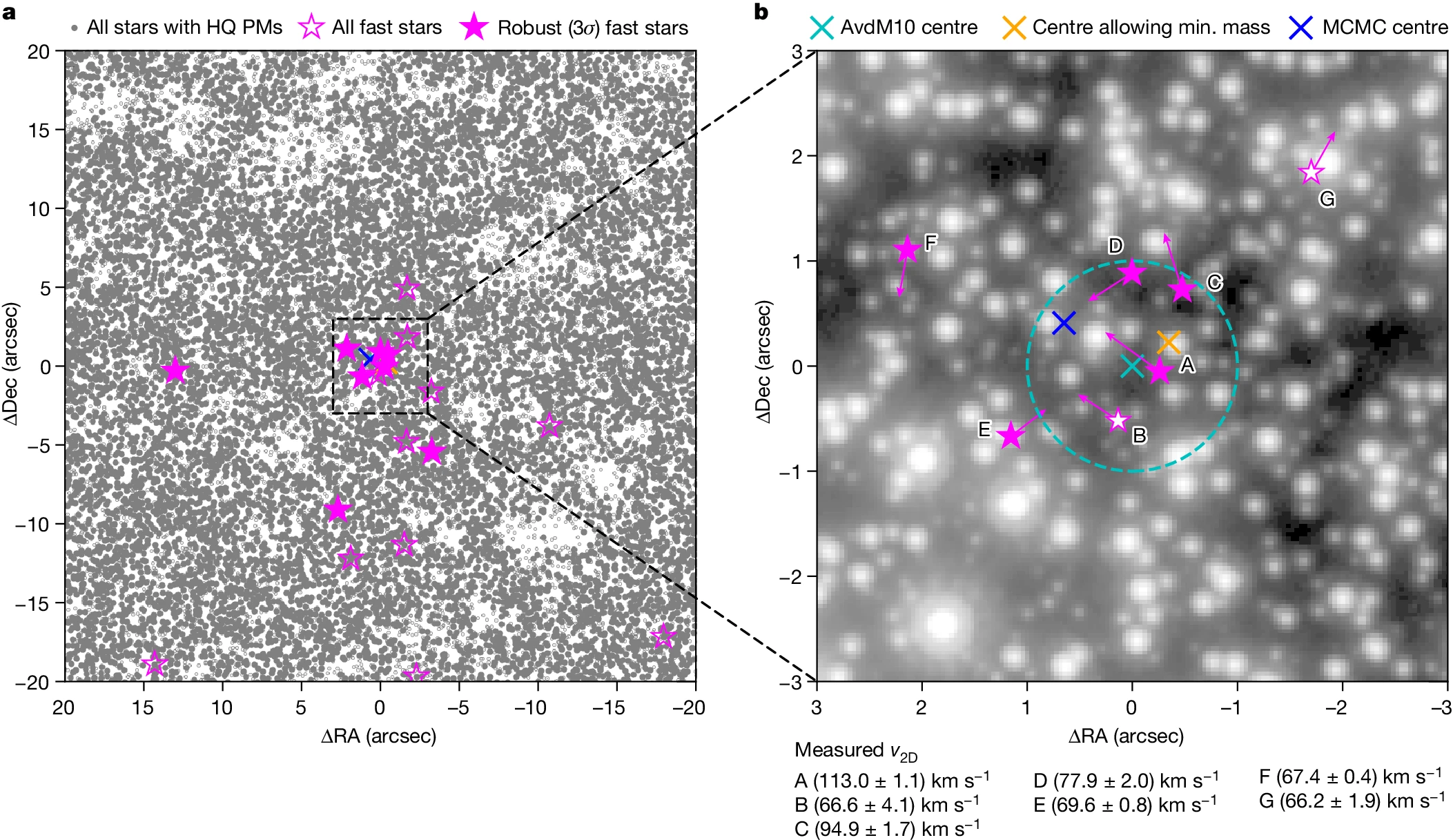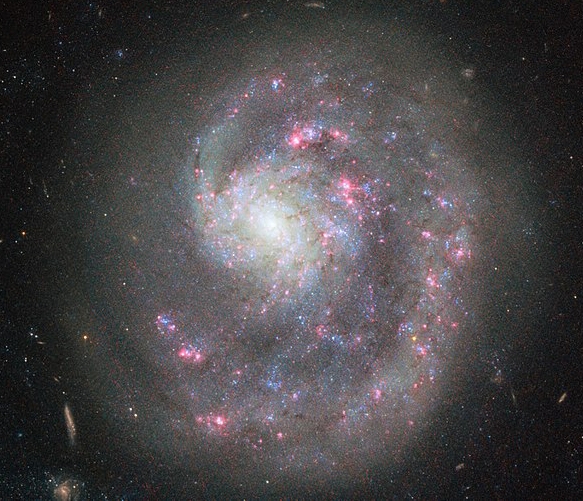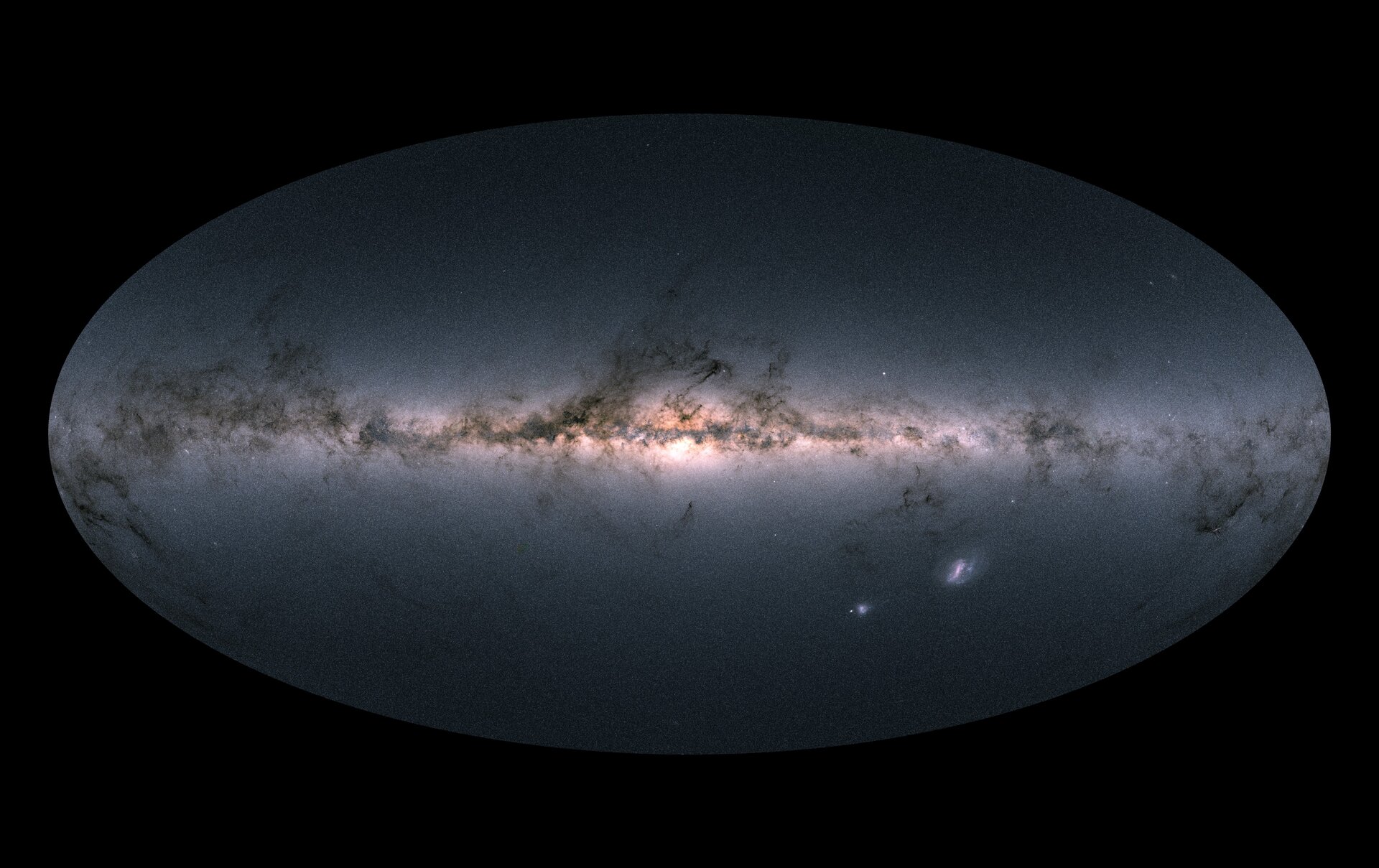Page 1 of 1
APOD: Globular Cluster Omega Centauri (2024 Jul 11)
Posted: Thu Jul 11, 2024 4:06 am
by APOD Robot
 Globular Cluster Omega Centauri
Explanation:
Globular Cluster Omega Centauri
Explanation: Globular star cluster
Omega Centauri packs about 10 million stars much older than the Sun into a volume some 150 light-years in diameter. Also known as NGC 5139, at a distance of 15,000 light-years it's the largest and brightest of 200 or so known
globular clusters that roam the halo of our Milky Way galaxy. Though most star clusters consist of stars with the same age and composition, the enigmatic Omega Cen exhibits the presence of
different stellar populations with a spread of ages and chemical abundances. In fact,
Omega Cen may be the
remnant core of a small galaxy merging with the Milky Way. With a
yellowish hue, Omega Centauri's red giant stars are easy to pick out in this
sharp telescopic view. A two-decade-long exploration of the dense star cluster with the Hubble Space Telescope has revealed evidence for a massive black hole near the
center of Omega Centauri.
Re: APOD: Globular Cluster Omega Centauri (2024 Jul 11)
Posted: Thu Jul 11, 2024 4:51 am
by shaileshs
1) I LOVE globular star clusters (colored and shaped nebulae next best!). Have been able to see 1-2 during star parties from Mt Hamilton in San Jose, CA.
2) I wondered how someone could say there were 10 million stars in the cluster when we can't even differentiate one star from other in most of central region. Then I followed the link at the end (center of Omega Centauri) and i see images zoomed enough to see each star separately. I am amazed. And, they show possible location of black hole because they were able to study fast moving 7 stars near the center.. Wow..
3) I simply can't imagine a view and experience standing on some planet of the star in that inner core region.. 10 million stars around that planet in such a compact region (barely 40 times distance between our Sun and Alpha Centauri).. How it'd feel standing there and seeing so much "Sun"light during day and I'd imagine non-existing night/darkness (because of millions of stars nearby showering their light on that planet).. ?
Re: APOD: Globular Cluster Omega Centauri (2024 Jul 11)
Posted: Thu Jul 11, 2024 5:14 am
by Ann
I remember when I was young...
I used to be a handsome spiral galaxy!
Granted, I was small (and maybe I was smaller than I remember)
But then I got captured by a big bully of a galaxy!
I lost my beautiful arms...
And now I'm an emaciated ghost of what I was!
Sad greetings from Omega Centauri via my secretary Ann
Re: APOD: Globular Cluster Omega Centauri (2024 Jul 11)
Posted: Thu Jul 11, 2024 9:56 am
by VictorBorun
Fast-moving stars around an intermediate-mass black hole in ω Centauri
The fastest and the centremost star (Fig. 1, star A) has a 2D proper motion of 4.41 ± 0.08 mas/yr (113.0 ± 1.1 km/s).
This is higher than the escape velocity of the cluster if no IMBH is present, v_esc = 62 km/s.
The combined constraint from the velocities of the five robustly measured fast-moving stars is about 8,200M_☉, thus making an intermediate-mass black hole the only plausible solution.

Re: APOD: Globular Cluster Omega Centauri (2024 Jul 11)
Posted: Thu Jul 11, 2024 9:58 am
by VictorBorun
then again whether that IMBH is a binary or multiple we have no idea
Re: APOD: Globular Cluster Omega Centauri (2024 Jul 11)
Posted: Thu Jul 11, 2024 11:50 am
by Christian G.
Ann wrote: ↑Thu Jul 11, 2024 5:14 am
I remember when I was young...
APOD 11 July annotated.png
I used to be a handsome spiral galaxy!
Granted, I was small (and maybe I was smaller than I remember)
But then I got captured by a big bully of a galaxy!
I lost my beautiful arms...
And now I'm an emaciated ghost of what I was!
Milky Way Gaia annotated.png
Sad greetings from Omega Centauri via my secretary Ann
Let not your past sadden you, beautiful Omega Centauri, you are today the unrivalled king of us all.
Forever your admirer,
The great Hercules cluster
Re: APOD: Globular Cluster Omega Centauri (2024 Jul 11)
Posted: Thu Jul 11, 2024 4:00 pm
by Ham Todd
I often wonder what the sky would look like for a person living on a planet that orbited around a star in this cluster! I'm pretty sure the view would be awesome!
Re: APOD: Globular Cluster Omega Centauri (2024 Jul 11)
Posted: Thu Jul 11, 2024 4:31 pm
by Chris Peterson
Ham Todd wrote: ↑Thu Jul 11, 2024 4:00 pm
I often wonder what the sky would look like for a person living on a planet that orbited around a star in this cluster! I'm pretty sure the view would be awesome!
Except it's not likely that many stars in a globular cluster have planets.
Re: APOD: Globular Cluster Omega Centauri (2024 Jul 11)
Posted: Thu Jul 11, 2024 5:23 pm
by Ann
Chris Peterson wrote: ↑Thu Jul 11, 2024 4:31 pm
Ham Todd wrote: ↑Thu Jul 11, 2024 4:00 pm
I often wonder what the sky would look like for a person living on a planet that orbited around a star in this cluster! I'm pretty sure the view would be awesome!
Except it's not likely that many stars in a globular cluster have planets.
The view from inside a rich globular cluster might be something like this:
Inside globular cluster 47 Tucanae. Illustration:
William Harris and Jeremy Webb
But Chris is right that there is not likely to be a lot of planets in 47 Tucanae. Or, more precisely, there is not likely to be many planets in well-ordered, near-circular orbits around their stars, in the way that most of the planets in our own solar orbit the Sun. In 47 Tuc, many planets are likely to be torn away from their suns due to tidal interactions with so many other stars passing by all too nearby.
Those planets that remain in orbit around their stars in 47 Tuc may have extremely elongated orbits, which would severely diminish the chances for life to get a foothold there.
Ann
Re: APOD: Globular Cluster Omega Centauri (2024 Jul 11)
Posted: Thu Jul 11, 2024 6:53 pm
by Holger Nielsen
As a courtesy to an APOD contributor that person’s name should be spelled correctly. From the last month:
Contributor Character ASCII Unicode
Jürgen Stein ü 0252 00FC
Göran Strand ö 0246 00F6
Tunç Tezel ç 0231 00E7
It’s not that difficult.
Re: APOD: Globular Cluster Omega Centauri (2024 Jul 11)
Posted: Thu Jul 11, 2024 7:31 pm
by Roy
VictorBorun wrote: ↑Thu Jul 11, 2024 9:56 am
Fast-moving stars around an intermediate-mass black hole in ω Centauri
The fastest and the centremost star (Fig. 1, star A) has a 2D proper motion of 4.41 ± 0.08 mas/yr (113.0 ± 1.1 km/s).
This is higher than the escape velocity of the cluster if no IMBH is present, v_esc = 62 km/s.
The combined constraint from the velocities of the five robustly measured fast-moving stars is about 8,200M_☉, thus making an intermediate-mass black hole the only plausible solution.

Reading through the Nature article, i am getting the following sequence of events regarding this globular cluster of estimated 10 million stars:
- look at a 2D plot of the 3D cluster
- measure some tiny positional shifts of stars near the center
- using assumed distances calculate velocities assumed to be orbital velocities
- infer a central massive object being orbited
Apply all kinds of statistics (massages) to the data so as to improve likelihood of correctness (and obscure accuracy of such distant measurement).
The center of this globular cluster must be a welter of gravitational, magnetic, and solar winds (electric fields). How far are the stars apart there? Not sure, but planets can be found even around close binaries.
Re: APOD: Globular Cluster Omega Centauri (2024 Jul 11)
Posted: Thu Jul 11, 2024 8:27 pm
by Chris Peterson
Roy wrote: ↑Thu Jul 11, 2024 7:31 pm
VictorBorun wrote: ↑Thu Jul 11, 2024 9:56 am
Fast-moving stars around an intermediate-mass black hole in ω Centauri
The fastest and the centremost star (Fig. 1, star A) has a 2D proper motion of 4.41 ± 0.08 mas/yr (113.0 ± 1.1 km/s).
This is higher than the escape velocity of the cluster if no IMBH is present, v_esc = 62 km/s.
The combined constraint from the velocities of the five robustly measured fast-moving stars is about 8,200M_☉, thus making an intermediate-mass black hole the only plausible solution.

Reading through the Nature article, i am getting the following sequence of events regarding this globular cluster of estimated 10 million stars:
- look at a 2D plot of the 3D cluster
- measure some tiny positional shifts of stars near the center
- using assumed distances calculate velocities assumed to be orbital velocities
- infer a central massive object being orbited
Apply all kinds of statistics (massages) to the data so as to improve likelihood of correctness (and obscure accuracy of such distant measurement).
The center of this globular cluster must be a welter of gravitational, magnetic, and solar winds (electric fields). How far are the stars apart there? Not sure, but planets can be found even around close binaries.
The distance to the center of the cluster is known with very high accuracy (5.24±0.11 kpc based on Gaia parallax) so the positional shifts of seven stars close to the center yield accurate
radial velocity values, which define
minimum 3D velocities. As those velocities are greater than the cluster escape velocity, the most physically reasonable mechanism is an unseen mass which they are orbiting. Electric and magnetic fields do not influence the orbits of stars.
Re: APOD: Globular Cluster Omega Centauri (2024 Jul 11)
Posted: Thu Jul 11, 2024 8:58 pm
by VictorBorun
Chris Peterson wrote: ↑Thu Jul 11, 2024 8:27 pm
The distance to the center of the cluster is known with very high accuracy (5.24±0.11 kpc based on Gaia parallax) so the positional shifts of seven stars close to the center yield accurate
radial velocity values, which define
minimum 3D velocities. As those velocities are greater than the cluster escape velocity, the most physically reasonable mechanism is an unseen mass which they are orbiting. Electric and magnetic fields do not influence the orbits of stars.
you must mean
tangent velocities, right?

radial Doppler velocities of 100 km/s can be measured with good enough radio telescope — I mean they
can see Doppler shift in Venus's radio spectrum, cannot they?
Re: APOD: Globular Cluster Omega Centauri (2024 Jul 11)
Posted: Thu Jul 11, 2024 9:13 pm
by Chris Peterson
VictorBorun wrote: ↑Thu Jul 11, 2024 8:58 pm
Chris Peterson wrote: ↑Thu Jul 11, 2024 8:27 pm
The distance to the center of the cluster is known with very high accuracy (5.24±0.11 kpc based on Gaia parallax) so the positional shifts of seven stars close to the center yield accurate
radial velocity values, which define
minimum 3D velocities. As those velocities are greater than the cluster escape velocity, the most physically reasonable mechanism is an unseen mass which they are orbiting. Electric and magnetic fields do not influence the orbits of stars.
you must mean
tangent velocities, right?

radial Doppler velocities of 100 km/s can be measured with good enough radio telescope — I mean they
can see Doppler shift in Venus's radio spectrum, cannot they?
Terminology can be confusing. In this case, by "radial" I mean in the frame of the image, so perpendicular to the line-of-sight. A line of site velocity might be determined from an optical Doppler measurement. I don't know of the resolution of our radio telescopes is high enough to isolate individual stars in the center of Omega Centauri.
Re: APOD: Globular Cluster Omega Centauri (2024 Jul 11)
Posted: Fri Jul 12, 2024 12:57 am
by VictorBorun
Ann wrote: ↑Thu Jul 11, 2024 5:23 pm
Chris Peterson wrote: ↑Thu Jul 11, 2024 4:31 pm
Ham Todd wrote: ↑Thu Jul 11, 2024 4:00 pm
I often wonder what the sky would look like for a person living on a planet that orbited around a star in this cluster! I'm pretty sure the view would be awesome!
Except it's not likely that many stars in a globular cluster have planets.
The view from inside a rich globular cluster might be something like this:
Inside 47 Tucanae William Harris and Jeremy Webb.png
Inside globular cluster 47 Tucanae. Illustration:
William Harris and Jeremy Webb
But Chris is right that there is not likely to be a lot of planets in 47 Tucanae. Or, more precisely, there is not likely to be many planets in well-ordered, near-circular orbits around their stars, in the way that most of the planets in our own solar orbit the Sun. In 47 Tuc, many planets are likely to be torn away from their suns due to tidal interactions with so many other stars passing by all too nearby.
Those planets that remain in orbit around their stars in 47 Tuc may have extremely elongated orbits, which would severely diminish the chances for life to get a foothold there.
Ann
what do we know of life and kinds of life from Earth's history?
1) to emerge in any form using DNA it needed no more than 0.3 billion years.
As soon as heavy bombardment of the early Solar system stopped at year 700 million after Sun formed and the planets' surfaces were no longer melted now and then, our DNA genetic ancestors came to be. (I think if other DNA+protein creatures came to be earlier still, the heavy bombardment melted them away, the genes and all)
2) mass extinction events from hot/cold/chemical changes never stopped all the life
3) some or every one of those catastrophes accelerated evolutionary steps on the ladder of complex adaptation mechanisms up to rational thinking humans
So we do not know if a planet of difficult fate, going rogue iceball and then low-periastron hotball, is left sterile or get intelligent life in 1 billion years instead of Earth's 4.
Re: APOD: Globular Cluster Omega Centauri (2024 Jul 11)
Posted: Fri Jul 12, 2024 1:36 am
by Chris Peterson
VictorBorun wrote: ↑Fri Jul 12, 2024 12:57 am
Ann wrote: ↑Thu Jul 11, 2024 5:23 pm
Chris Peterson wrote: ↑Thu Jul 11, 2024 4:31 pm
Except it's not likely that many stars in a globular cluster have planets.
The view from inside a rich globular cluster might be something like this:
Inside 47 Tucanae William Harris and Jeremy Webb.png
Inside globular cluster 47 Tucanae. Illustration:
William Harris and Jeremy Webb
But Chris is right that there is not likely to be a lot of planets in 47 Tucanae. Or, more precisely, there is not likely to be many planets in well-ordered, near-circular orbits around their stars, in the way that most of the planets in our own solar orbit the Sun. In 47 Tuc, many planets are likely to be torn away from their suns due to tidal interactions with so many other stars passing by all too nearby.
Those planets that remain in orbit around their stars in 47 Tuc may have extremely elongated orbits, which would severely diminish the chances for life to get a foothold there.
Ann
what do we know of life and kinds of life from Earth's history?
1) to emerge in any form using DNA it needed no more than 0.3 billion years.
As soon as heavy bombardment of the early Solar system stopped at year 700 million after Sun formed and the planets' surfaces were no longer melted now and then, our DNA genetic ancestors came to be. (I think if other DNA+protein creatures came to be earlier still, the heavy bombardment melted them away, the genes and all)
2) mass extinction events from hot/cold/chemical changes never stopped all the life
3) some or every one of those catastrophes accelerated evolutionary steps on the ladder of complex adaptation mechanisms up to rational thinking humans
So we do not know if a planet of difficult fate, going rogue iceball and then low-periastron hotball, is left sterile or get intelligent life in 1 billion years instead of Earth's 4.
We're talking planets in a GC that aren't in orbit around stars. Given the most reasonable form life might take (for a variety of reasons) being carbon-based chemistry in an aqueous environment, we would not expect to see it on a rogue planet, except maybe in some very simple form around volcanic vents under oceans maintained by hot cores. The mass extinctions on Earth have been trivial compared with what we would see on a planet that orbited in and out of the Goldilocks zone, or experienced extreme axial tilts, and that's what we'd expect for the small number of planets that might be bound to stars still. Complex life requires a fair degree of stability.
 Globular Cluster Omega Centauri
Globular Cluster Omega Centauri


